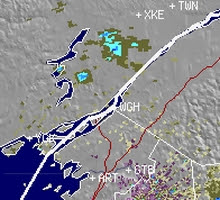 |
| #1694 "Mallorytown Cloud Streets" 5x7 inches oils on smooth panel |
This is the cloud and plein air demonstration that I did for the Thousand Islands Artists Association (TIAA) in late November 2015. I simply backed up the red, Subaru Forester paint-mobile and set up my plein air kit in the yard behind the Mallorytown Library. I did not want the 15 or so participants to have to walk anywhere. Inspiration is everyone if you look for it.
 |
| Radar View of the Towering Cumulus Flurries |
I described the approach to the painting process during the demonstration and added a bit of "why" as well. The conversation strayed to common inquiries one receives while plein air painting. "How long does it take?" "How much does it cost?" "My great Aunt painted beautiful work."
 |
| George Washington 1796 Lansdowne-Portrait |
In George Washington's days, there were no cameras. One's image was either sculpted or painted. Some paintings of George Washington showed him standing behind a desk with one arm behind his back while others showed both legs and both arms. Prices charged by painters were not based on how many people were to be painted, but on how many limbs were to be painted. Arms and legs are 'limbs,' therefore painting them would cost the buyer more. Hence the expression, 'Okay, but it'll cost you an arm and a leg.' Artists know hands and arms are more difficult to paint. The church and state were typically the only patrons who could afford all of the limbs.
For this and much more art, click on Pixels.
Warmest regards and keep your paddle in the water,
Phil Chadwick




No comments:
Post a Comment